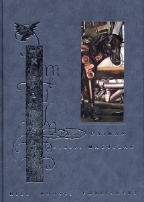 |
 Neil Gaiman
Neil Gaiman
Melinda
Reviewed by: Rick Kleffel © 2005
Illustrated by Dagmara Matuszak
Hill House Publishers
US Hardcover Limited First Edition
ISBN 0-931-77104-8
Publication Date: 12-11-2004
56 Pages; Neil Gaiman Subscription Extra
Date Reviewed: 01-13-05
Index:
General Fiction
Fantasy
In spite of the cries of censors throughout the ages, books usually don't make readers do anything beyond read them. Great books will put ideas in your mind that might not have been there before, and once those ideas are planted, you'll see the world anew, and perhaps change your behavior accordingly. But in general, books don't bring to bear a physical compulsion. I've never read a book that made my body move against my will. But between Neil Gaiman's prose and Dagmara Matuszak's illustrations and design, while reading Hill House's 'Melinda', I found my lips moving and my mouth speaking in tongues -- in Neil Gaiman's words, to be specific. It was purely a physical compulsion, unstoppable, a linguistic twitch, the likes of which I've never experienced.
Of course, the same may be said for Gaiman's collaboration with Matuszak. As it happens, words are pretty sparse in this book. But they're correspondingly rather more powerful than usual. The few that you'll find tell the story of a young girl who takes a walk through a forbidding post-industrial landscape. That's it. But frankly, this is not prose, but rather poetry. And this is no book like any I've ever seen. It's an innovative and rather experimental stab at using the format of a children's book to address a sophisticated adult audience. Or, you might call it a 56 page illuminated poem. It really fits into no category of publication I've ever read or rather, experienced.
Experience is an important word here. Gaiman's sparse prose is counter-pointed and illuminated by Matuszak's intense visualizations. There are two styles elegantly combined in this book. The majority of each page is taken up by a large pen-and-ink drawing. These images are detailed and carefully drawn. Sometimes they offer up stark vistas of deep black, purely printed on the red-speckled paper. At other times, they present meticulous re-creations of a wasted landscape of discarded machinery. The mood Matuszak creates with these drawings is carefully matched to Gaiman's poetry.
Matuszak also provides numerous inset color paintings. The cover image gives an idea what you can expect. They're dark, flowing and gorgeously glowing. They add the proper dash of color to the otherwise stark landscapes. And they bear repeated viewings, as beautiful details well up and merge into forms unseen the first, the second, the third time you view them.
Gaiman's poem underpins the illustrations with quiet urgency and subtle power. What happened to me as I read this was that I quickly found myself reading it aloud. I couldn't help myself. It was, as I said above, a purely physical compulsion. Part of this was, I'm sure, the desire to slow my progress through the book, to give myself time to absorb each image. But part of it was the language itself. At first, I was uncertain, but gradually it dawned on me that this was meant to be spoken aloud. I realized this after I began speaking.
The fact that any of this works as well as it does is entirely due to the high production values that Hill House brings to the finished product. Printed in Poland by a company called Off-Print Printing, 'Melinda' is created using paper imported from Germany specially for this project. The red flecks that give the book its unique look are bits of colored paper mixed into the pulp before the paper was pressed. The color prints are carefully mounted into the book, so they merge within the deep, resonant blacks that shadow the pages. It's shipped in a gray envelope with the Tesla cat painting attached. The book is beautiful enough that you'll want to get out your Demco reading gloves before touching it.
Gaiman, Matuszak and Hill House have created in 'Melinda' an entirely new form of literature. This is not a graphic novel. There's no plot, per se, and the characterization emerges more from the images than the words. The words are like the slowly cranking chain that drags an ancient figure (the reader) out of the bowels of a cuckoo clock and into the light, only to drag it back in again. It's a poem, spread out across 56 pages and illuminated by the illustrations. As such, it has much in common with books for very young readers, like Gaiman's collaboration with Dave McKean, 'The Day I Swapped my Dad for Two Goldfish'.
But 'Melinda' is not for children. This is not to say that a child would not enjoy it, but the images and language are quite sophisticated. It has more in common with music, or sculpture than it does with either a novel or a graphic novel. Hill House tells us that Gaiman and Matuszak plan further collaborations, and we can only be glad. Whatever 'Melinda' might be, it is without doubt powerful, intelligently conceived and flawlessly executed. And unlike so many books, this is a book that will make you do something. It will make you see the world anew. It will make you feel.
|
 |
